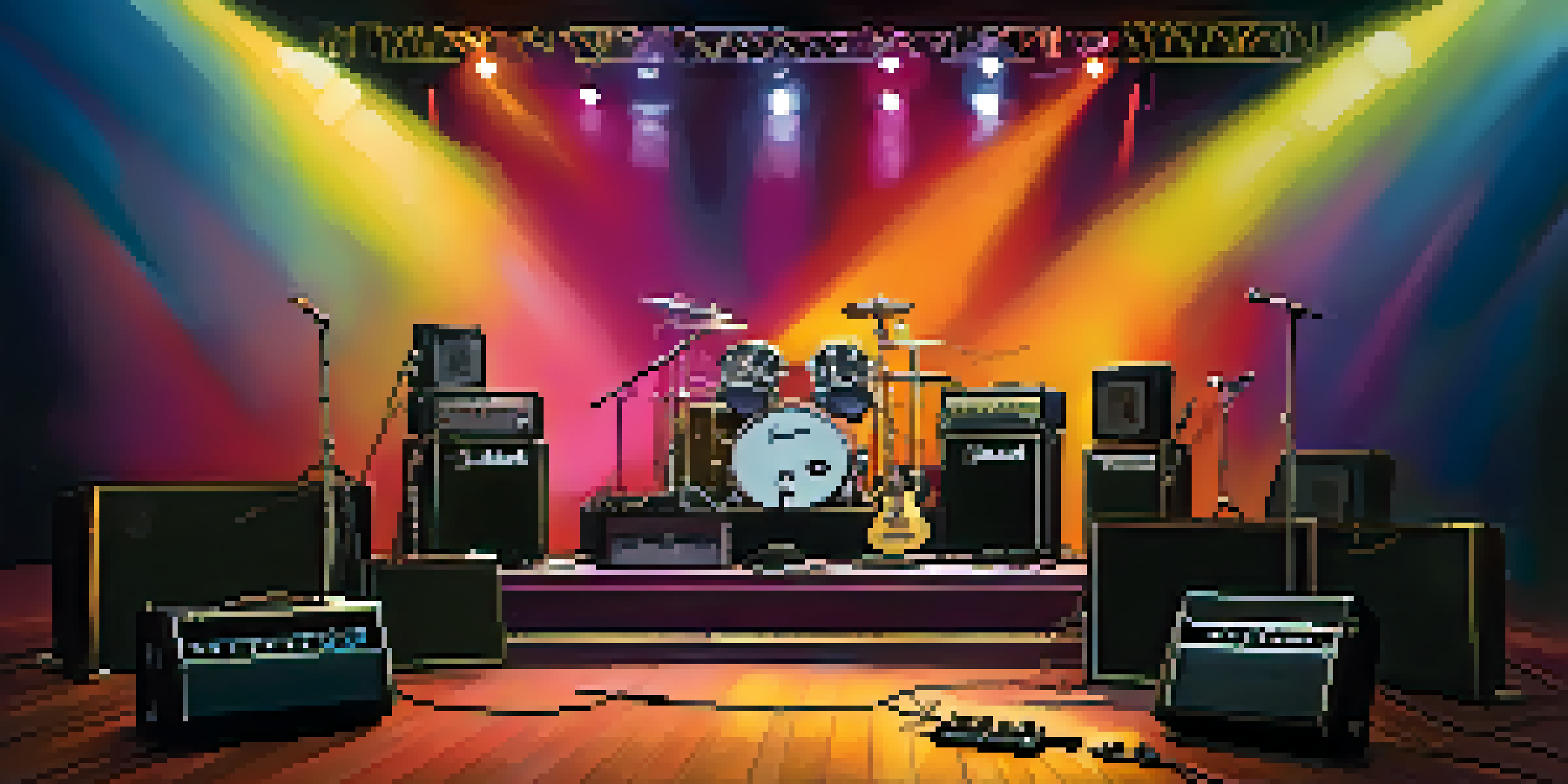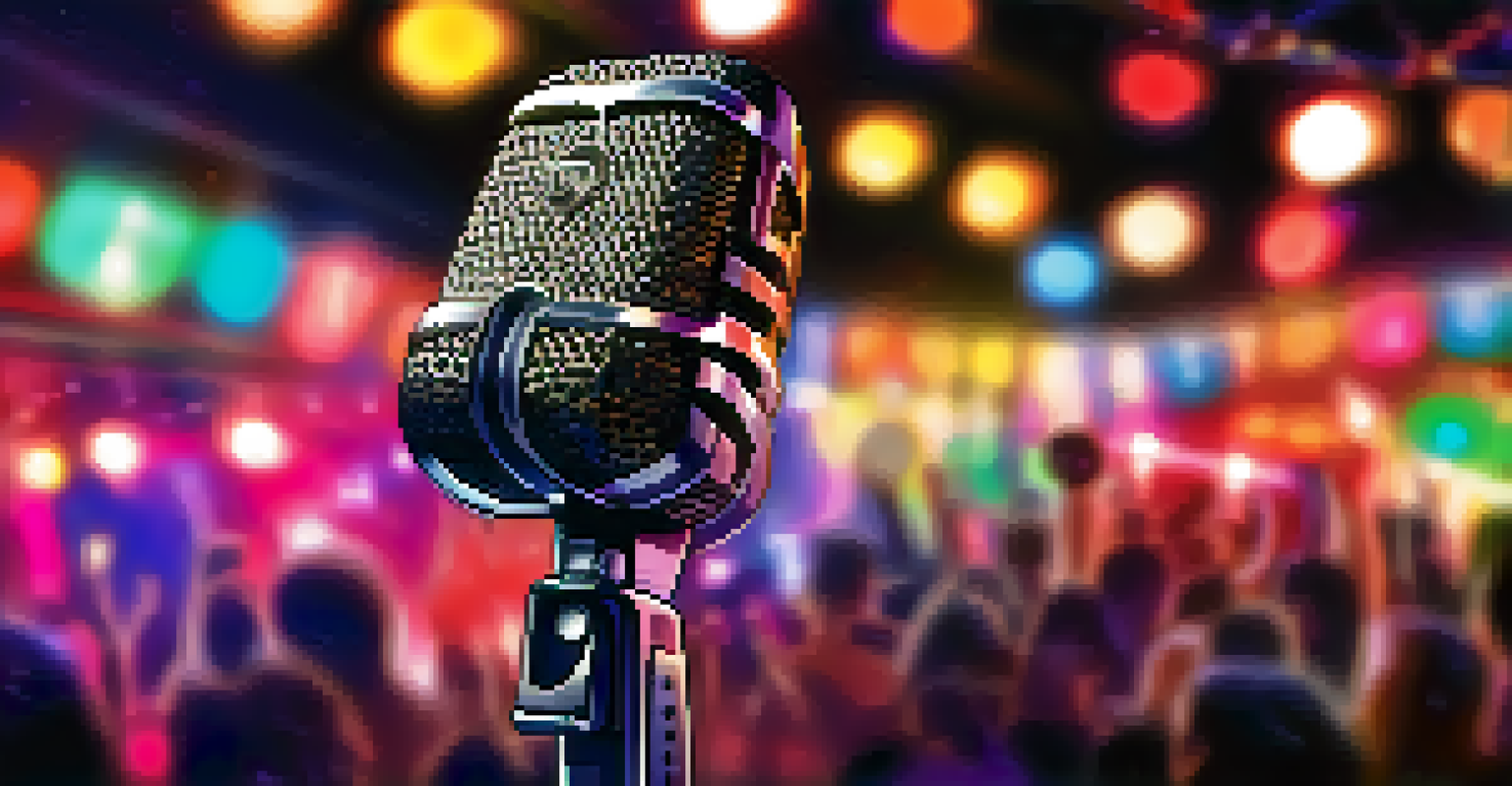Essential Live Sound Gear for Guitarists: A Complete Guide

Understanding the Basics of Live Sound Gear for Guitarists
When it comes to live performances, having the right sound gear is crucial for guitarists. It’s not just about playing well; the audience experience depends on clear and balanced sound. In this section, we'll break down the fundamental components every guitarist should be familiar with.
The sound of a guitar is a beautiful thing, but it’s only as good as the equipment you use to amplify it.
From amplifiers to microphones, understanding how each piece of equipment works together can make or break your performance. Think of your live sound gear as the foundation of a house: without a solid base, everything else can crumble. Let’s explore the essential pieces that create that solid foundation.
By mastering the basics, you’ll not only enhance your sound but also gain confidence on stage. This knowledge allows you to troubleshoot issues quickly and communicate effectively with sound engineers and technicians. So, let’s dive deeper into the essential gear you’ll need.
The Importance of a Quality Guitar Amplifier
A good guitar amplifier is the heart of your live sound setup. It amplifies your guitar's tone and character, allowing your unique sound to shine through in a live setting. Choosing the right amp can greatly impact your performance, so it’s worth investing time in understanding your options.

There are a variety of amplifiers, including tube, solid-state, and modeling amps, each offering different tones and features. For example, tube amps are known for their warm, rich sound, while solid-state amps are often more reliable and versatile. Finding an amp that suits your style can elevate your live performances significantly.
Essential Gear for Guitarists
Understanding the basic components of live sound gear, like amplifiers and microphones, ensures a successful performance.
Additionally, consider factors like wattage and portability when selecting an amplifier. A powerful amp is essential for larger venues, while a lighter model might be more practical for gigs in smaller spaces. Ultimately, your amp should complement your playing style and help convey your musical vision.
Choosing the Right Microphone for Your Vocals
If you’re a guitarist who also sings, having the right microphone is essential for ensuring your vocals are heard clearly. A quality microphone can enhance your vocal tone and help you connect with your audience. Let’s explore how to choose the right mic for your needs.
A great performance is built on a solid foundation of sound. Without it, the music can lose its magic.
Dynamic microphones are popular for live performances due to their durability and ability to handle high sound pressure levels. On the other hand, condenser microphones often provide a wider frequency response and greater sensitivity, making them ideal for capturing nuanced vocal performances. Understanding the differences can help you make an informed choice.
Don’t forget about accessories like mic stands and pop filters, which can further improve sound quality. A sturdy stand ensures your microphone stays in place during your performance, while a pop filter minimizes unwanted noise. Together, these components create a professional sound setup that enhances your overall performance.
Essential Effects Pedals for Personalizing Your Sound
Effects pedals are a fantastic way for guitarists to add personality and depth to their sound. Whether you want to create lush reverbs or gritty distortions, the right pedals can transform your guitar tone and enhance your live performances. Let’s take a look at the must-have effects for every guitarist.
Common effects include reverb, delay, overdrive, and chorus, each serving a unique purpose. For instance, reverb can create a sense of space, while delay adds depth and complexity to your sound. By experimenting with different pedals, you can discover what best complements your style.
Importance of Quality Amplifiers
A good guitar amplifier is crucial as it amplifies your tone, impacting the overall sound and performance quality.
When building your pedalboard, consider the order in which you place your pedals, as this can greatly affect your overall tone. A well-thought-out pedalboard not only allows for creative expression but also makes it easier to manage your sound during live shows. Always remember, your pedals should enhance your music, not overwhelm it.
Using a Quality DI Box for Optimal Sound Quality
A Direct Injection (DI) box is an essential tool for guitarists looking to achieve optimal sound quality during live performances. It helps connect your guitar to the sound system while preserving the integrity of your signal. Understanding how to use a DI box properly can greatly enhance your live sound.
DI boxes come in active and passive varieties, each suited for different setups. Active DI boxes require power, usually from a battery or phantom power, while passive boxes work without external power. Knowing which type suits your needs can make a significant difference in your sound quality.
Using a DI box not only helps with sound fidelity but also minimizes noise and interference. This is particularly important when playing in larger venues where long cable runs can introduce unwanted noise. By incorporating a DI box into your setup, you'll ensure that your guitar's true tone shines through.
Understanding Monitors and Their Role in Live Sound
Stage monitors are crucial for performers, allowing you to hear yourself and your bandmates clearly while playing live. This is especially important for guitarists who need to stay in sync with the rest of the band. Let’s explore the different types of monitors and how they can enhance your performance.
Wedge monitors are the most common type and are positioned on the stage floor, aimed at the performers. In-ear monitors (IEMs), on the other hand, provide a more personal listening experience by delivering sound directly into your ears. Each type has its advantages, and your choice should depend on your comfort and performance needs.
Role of Stage Monitors
Stage monitors are vital for performers, helping musicians hear themselves and each other clearly during live shows.
Investing in a good monitoring system can significantly improve your performance quality. With proper monitoring, you can focus on your playing without worrying about whether you can hear yourself or the other musicians. Ultimately, effective monitoring helps create a cohesive sound on stage.
Setting Up a Reliable PA System for Live Performances
A reliable PA (Public Address) system is essential for ensuring your music reaches your audience clearly and powerfully. This system amplifies your sound, making sure every note and lyric is heard without distortion. Let’s dive into the components needed to set up a solid PA system.
Key components of a PA system include speakers, mixers, and amplifiers. The speakers project your sound, while the mixer allows you to control levels and effects. Understanding how these components work together is crucial for achieving great sound during live performances.

When setting up your PA system, consider the size of the venue and the number of performers. Larger venues may require additional speakers and monitors to ensure even sound distribution. A well-planned PA setup can make a significant difference in the overall audience experience, allowing you to shine on stage.